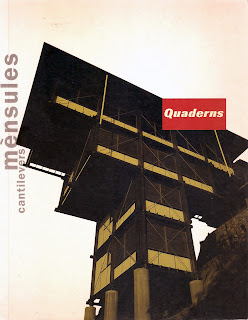 |
| Forum 2004 Building, Herzog & de Meuron |
Despite appearances, though, this cantilever race is not really very different from the skyscraper race. As every structural engineer knows (along with, hopefully, most architects), skyscrapers have to be designed as vertical cantilevers because they must resist, "above all", wind forces. Seen in this light, the current cantilever race is a horizontal skyscraper race of sorts. Horizontal has become the new vertical.
Barcelona, perhaps in its bid to outdo Dubai at something, has been participating in this cantilever race wholeheartedly. A good example of Catalan Cantileverisme is the Catalan Filmothèque, a veritable concrete bunker by Catalan architect Josep Lluis Mateo (professor at the ETH in Zürich and a founder of the BIArch) that is currently being completed just a few blocks from my home in the Raval neighbourhood of Barcelona. It sports a massive, post-tensioned concrete cantilever reaching over a narrow street, nearly touching the balconies of its residential neighbours. But, what is the cantilever for? What is it doing? Is it sheltering the entrance to the building? No, it only shelters a utility door to an electrical transformer. Is it creating public space? Yes, but not a public space with any qualities, since it is merely widening a dark and dingy street known for vice with a dark and dingy "plaçeta". Unless it is deliberately intended to provide a shady spot for junkies to shoot up or for prostitutes to turn a trick, which I don't think is the case, then just what is the cantilever doing, precisely? Nothing, unless looking impressive (or oppressive, better said) counts as doing something. For all the talk these days about "performance" in architecture...
 |
| Filmothèque of Catalonia, Josep Lluis Mateo |
But this is not an isolated case. In fact Barcelona abounds with cantilevers of all shapes, sizes and pretexts. The following is a photographic tour of some of the cantilevers of Barcelona:
 |
| Fire station, Manuel Ruisánchez |










No comments:
Post a Comment